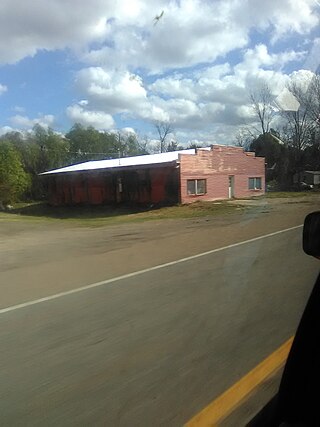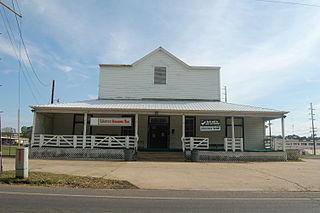
Natchez is a village in Natchitoches Parish, Louisiana, United States. The population was 597 at the 2010 census. It is part of the Natchitoches Micropolitan Statistical Area. The village and parish are part of the Cane River National Heritage Area and located on Isle Brevelle.

Natchitoches, officially the City of Natchitoches, is a small city and the parish seat of Natchitoches Parish, Louisiana, United States. At the 2020 United States Census, the city's population was 18,039. Established in 1714 by Louis Juchereau de St. Denis as part of French Louisiana, the community was named after the indigenous Natchitoches people.

Established in 1994, the Cane River Creole National Historical Park serves to preserve the resources and cultural landscapes of the Cane River region in Natchitoches Parish, Louisiana. Located along the Cane River Lake, the park is approximately 63 acres and includes two French Creole cotton plantations, Oakland and Magnolia. Both plantations are complete in their historic settings, including landscapes, outbuildings, structures, furnishings, and artifacts; and they are the most intact French Creole cotton plantations in the United States. In total, 65 historic structures and over a million artifacts enhance the National Park Service mission as it strives to tell the story of the evolution of plantation agriculture through the perspective of the land owners, enslaved workers, overseers, skilled workers, and tenant farmers who resided along the Cane River for over two hundred years. This park is included as a site on the Louisiana African American Heritage Trail.
Marie Thérèse Coincoin, born as Coincoin, also known as Marie Thérèse dite Coincoin, and Marie Thérèse Métoyer, was a planter, slave owner, and businesswoman at the colonial Louisiana outpost of Natchitoches.
The Cane River National Heritage Area is a United States National Heritage Area in the state of Louisiana. The heritage area is known for plantations featuring Creole architecture, as well as numerous other sites that preserve the multi-cultural history of the area. The heritage area includes the town of Natchitoches, Louisiana and its national historic district. Founded in 1714, it is the oldest community in the territory covered by the Louisiana Purchase. Cane River Creole National Historical Park, including areas of Magnolia and Oakland plantations, also is within the heritage area.

Fort Jesup, also known as Fort Jesup State Historic Site or Fort Jesup or Fort Jesup State Monument, was built in 1822, 22 miles (35 km) west of Natchitoches, Louisiana, to protect the United States border with New Spain and to return order to the Neutral Strip. Originally named Cantonment Jesup, the fort operated from 1822 until 1846. After the abandonment of the fort in 1846, the United States federal government continued to own the abandoned fort site until the privatization of the site in 1869.

The Kate Chopin House, also known as the Bayou Folk Museum or Alexis Cloutier House, was a house in Cloutierville, Louisiana. It was the home of Kate Chopin, author of The Awakening, after her marriage.

Oakland Plantation, originally known as the Jean Pierre Emmanuel Prud'homme Plantation, and also known as Bermuda, is a historic plantation in an unincorporated area of Natchitoches Parish, Louisiana. Founded as a forced-labor farm worked by enslaved Black people for White owners, it is one of the nation's best and most intact examples of a French Creole cotton plantation complex. The Oakland Plantation is now owned by the National Park Service as part of the Cane River Creole National Historical Park.

Magnolia Plantation is a former cotton plantation in Natchitoches Parish, Louisiana. The site was declared a National Historic Landmark in 2001, significant as one of the most intact 19th-century plantation complexes in the nation, as it is complete with a suite of slave cabins and numerous outbuildings and period technology. Included in the Cane River Creole National Historical Park, Magnolia Plantation is also a destination on the Louisiana African American Heritage Trail. It is one of two plantations in the park; the other is Oakland Plantation.

Melrose Plantation, also known as Yucca Plantation, is a National Historic Landmark located in the unincorporated community of Melrose in Natchitoches Parish in north central Louisiana. This is one of the largest plantations in the United States built by and for free people of color. The land was granted to Louis Metoyer, who had the "Big House" built beginning about 1832. He was a son of Marie Thérèse Coincoin, a former slave who became a wealthy businesswoman in the area, and Claude Thomas Pierre Métoyer. The house was completed in 1833 after Louis' death by his son Jean Baptiste Louis Metoyer. The Metoyers were free people of color for four generations before the American Civil War.

St. Augustine Catholic Church and Cemetery, or the Isle Brevelle Church, is a historic Catholic parish property founded in 1829 near Melrose, Natchitoches Parish, Louisiana. It is the cultural center of the Cane River area's historic French, Spanish, Native American and Black Creole community. It is also the oldest surviving Black Catholic church in the United States.

Fort St. Jean Baptiste State Historic Site in Natchitoches, Louisiana, US, is a replica of an early French fort based upon the original 1716 blueprints by Sieur Du Tisné with the improvements made in 1731 by Boutin. The French called the original fort: Fort Saint Jean Baptiste des Natchitoches. In the 1970's, the State of Louisiana anglicized the name to Fort Saint Jean Baptiste.

The Oaklawn Plantation is a historic cotton plantation house in Natchitoches, Louisiana. It is located on the Louisiana Highway 494 east of Natchitoches in Natchitoches Parish, Louisiana. It has been listed on the National Register of Historic Places since March 28, 1979.

The Jones House, on Louisiana Highway 154 along Cane River Lake near Melrose in Natchitoches Parish, Louisiana, was built in 1847. It was listed on the National Register of Historic Places in 1993.

Cherokee Plantation, also known as Emile Sompayrac Place and Murphy Place, is a former plantation and historic plantation house located in Natchez, Louisiana, near the city of Natchitoches. For many years this site was worked and maintained by enslaved African Americans. This location was part of the Côte Joyeuse area which was home to the earliest French planters in Louisiana.

Isle Brevelle is an ethnically and culturally diverse community, which began as a Native American and Louisiana Creole settlement and is located in Natchitoches Parish, Louisiana. For many years this area was known as Côte Joyeuse. It is considered the birthplace of Creole culture and remains the epicenter of Creole art and literature blending European, African, and Native American cultures. It is home to the Cane River Creole National Historical Park and part of the Louisiana African American Heritage Trail.

Caspiana Plantation Store is an American historic building and a former plantation store built in 1906, located at 1300 Texas Street in Natchitoches, Louisiana. The store served as part of the crop-lien system, during the time of sharecropping which impacted the lives of many African American workers.
Bayou Brevelle is a series of interconnected, natural waterways totaling over 18 miles in length in Natchitoches Parish, Louisiana. Its main channel is at Old River and Kisatchie Bayou at Montrose to Natchez near the Cane River. During heavy rains or floods, Bayou Brevelle joins the Cane River. The bayou is flanked by Interstate 49 on the west and the Cane River on the east, and is one of the many waterways on Isle Brevelle.
Jean Baptiste Brevelle was a Parisian-born trader, explorer, and one of the first soldiers garrisoned at Fort St. Jean Baptiste des Natchitoches in present-day Natchitoches, Louisiana and Le Poste des Cadodaquious in Texas.
Jean Baptiste Brevelle II was a French and Native American explorer, translator and soldier of the militia at Fort St. Jean Baptiste des Natchitoches in present-day Natchitoches, Louisiana and Le Poste des Cadodaquious in Texas.















